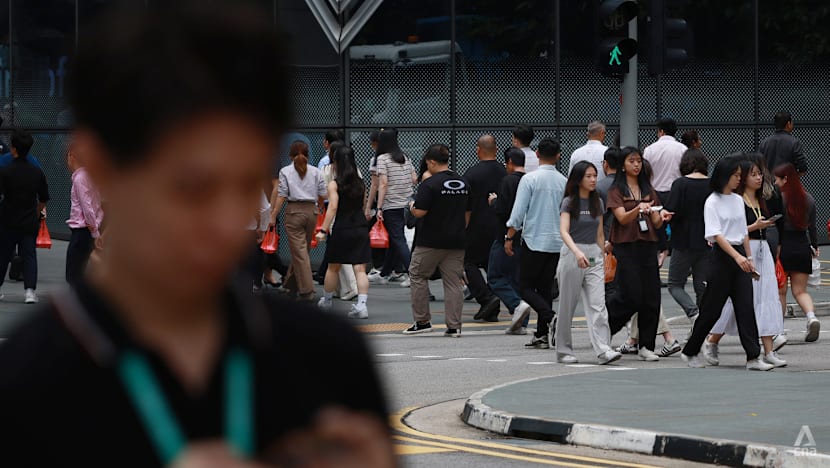Less job switching, especially by those in their 20s, suggests growing caution among workers, says MOM
Workers aged 25 to 29 saw the biggest drop in job switching, although they remain the most likely to have changed roles in the past year.


This audio is generated by an AI tool.
SINGAPORE: The share of resident workers who changed jobs in the past year fell to 6.2 per cent, down from 7.6 per cent in 2024, according to latest labour force data released on Friday (Nov 28).
This is the lowest since 2018, when the Ministry of Manpower (MOM) started measuring job mobility in one-year periods.
The decline may suggest workers are being more careful amid global uncertainties, even as it remains consistent with post-pandemic normalisation of the labour market, MOM said.
"This is part of the gradual downtrend over the recent three years, as job switching peaked in 2022 amid a tighter labour market following the post-COVID reopening of businesses.
"The decline in job switching may also reflect greater caution among workers amid external uncertainties this year," MOM said in an advance release of its labour force report.
The drop was seen across all age groups but was most pronounced among those aged 25 to 29, falling 2 percentage points to 11.7 per cent. This age group is still the most likely to have changed jobs.

MOM said these younger workers tend to switch jobs more frequently than older age groups as they explore career options.
"This suggests that while they are more opportunistic and mobile, they tend to be more sensitive to cyclical hiring. The more cautious stance from employers could contribute to the lower mobility among younger workers in 2025," said the ministry.
Lower job switching was accompanied by lower job-seeking activity, with the proportion of employed resident workers actively looking out for new jobs dropping to 6.2 per cent this year from 7.3 per cent in 2024.
Job switching eased in most sectors, particularly accommodation, administrative and support services and retail trade. This was likely due to better staff retention and less reliance on manpower, according to MOM.
Job switching also fell in the outward-oriented sectors of information and communications, financial and insurance services and professional services, which typically see high job mobility, said the ministry.
"While these sectors typically offer attractive compensation packages to attract and retain workers, job switching in these sectors may have eased in 2025 due to a few high-profile workforce restructurings and more cautious hiring sentiments amid economic uncertainty," the report said.
The ministry pointed out that for full-time employees who did change jobs, six in 10 enjoyed real income growth, suggesting opportunities for upward mobility remain.
Global economic uncertainty has persisted this year on the back of the United States' tariff actions and heightened geopolitical risks. Singapore has set up an economic resilience taskforce to deal with the impact of trade tensions.
The report also found that the share of Singapore workers in permanent jobs hit a record high in 2025, but the participation rate in the labour force among residents has continued to fall for the fourth year in a row.
SELF-EMPLOYED AND PLATFORM WORKERS
The proportion of self-employed workers, which includes platform workers, stayed low at 11.8 per cent in 2025. This figure has fallen in recent years as a post-pandemic hiring surge drew more workers into regular employee jobs, said MOM.
The number of residents who do self-employed work as their main job increased from 169,000 in 2024 to 179,200 this year.
The vast majority of them choose self-employment because they prefer it, with this share of workers rising to 95.5 per cent this year – the highest level since 2016.
Flexibility in working hours and location, freedom in choice of work and greater control over their careers are the most popular reasons for choosing self-employment.
In contrast, the number of workers who do self-employed work on the side of their main jobs fell from 32,100 in 2024 to 29,000 this year.
The number of platform workers rose to 71,600 this year, up from 67,200 in 2024. They make up 2.9 per cent of employed residents – comparable to the proportions in 2023 and the pre-pandemic period, said MOM.
The increase was driven by private-hire car drivers, who make up just over half of platform workers, reflecting stronger demand for their services. Numbers of taxi drivers and delivery workers remained stable.
The share of self-employed workers who faced challenges in their work dropped from 66 per cent in 2016 to 18.2 per cent this year, although there were increases during the pandemic years.
This reflects continuing efforts by the government and tripartite partners to address key concerns about healthcare, retirement, payment-related disputes and loss of income due to work injury, including through the Platform Workers Act, said MOM.
Uncertainty of finding enough work remained the top challenge faced by 9 per cent of self-employed workers, followed by lack of sufficient work and healthcare- and retirement-related concerns.
MOM's Comprehensive Labour Force Survey collected data from 33,000 households, with an overall response rate of 86.8 per cent.
The ministry also surveyed 3,363 residents for its supplementary survey of self-employed workers, of whom 92.5 per cent responded.











